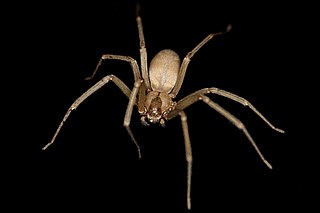
The brown recluse, Loxosceles reclusa, Sicariidae is a recluse spider with a necrotic venom. Similar to other recluse spider bites, their bite sometimes requires medical attention. The brown recluse is one of three spiders with medically significant venom in North America.

Arachnida is a class of joint-legged invertebrate animals (arthropods), in the subphylum Chelicerata. Arachnida includes orders containing spiders, scorpions, ticks, mites, harvestmen, and solifuges. In 2019, a molecular phylogenetic study also placed horseshoe crabs in Arachnida.

The Thomisidae are a family of spiders, including about 175 genera and over 2,100 species. The common name crab spider is often linked to species in this family, but is also applied loosely to many other families of spiders. Many members of this family are also known as flower spiders or flower crab spiders.
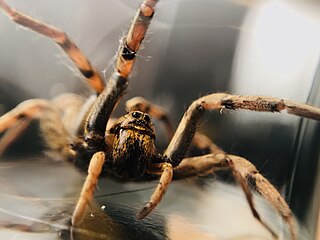
Wolf spiders are members of the family Lycosidae, from the Ancient Greek word "λύκος" meaning "wolf". They are robust and agile hunters with excellent eyesight. They live mostly in solitude and hunt alone, and do not spin webs. Some are opportunistic hunters pouncing upon prey as they find it or even chasing it over short distances. Some wait for passing prey in or near the mouth of a burrow.

Jumping spiders or the Salticidae are a family of spiders. As of 2019, it contained over 600 described genera and over 6000 described species, making it the largest family of spiders at 13% of all species. Jumping spiders have some of the best vision among arthropods and use it in courtship, hunting, and navigation. Although they normally move unobtrusively and fairly slowly, most species are capable of very agile jumps, notably when hunting, but sometimes in response to sudden threats or crossing long gaps. Both their book lungs and tracheal system are well-developed, and they use both systems. Jumping spiders are generally recognized by their eye pattern. All jumping spiders have four pairs of eyes, with the anterior median pair being particularly large.

Huntsman spiders, members of the family Sparassidae, are known by this name because of their speed and mode of hunting. They are also called giant crab spiders because of their size and appearance. Larger species sometimes are referred to as wood spiders, because of their preference for woody places. In southern Africa the genus Palystes are known as rain spiders or lizard-eating spiders. Commonly they are confused with baboon spiders from the Mygalomorphae infraorder, which are not closely related.
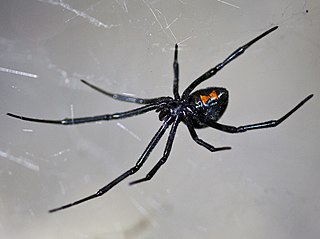
Latrodectus is a broadly distributed genus of spiders with several species that, together, are referred to as true widows. This group is composed of those often loosely called black widow spiders, brown widow spiders, and similar spiders. However, such general "common names" are of limited use as the diversity of species is much greater. A member of the family Theridiidae, this genus contains 32 species, which include several North American "black widows". In addition to these in North America are also the red widow Latrodectus bishopi and the brown widow Latrodectus geometricus, which, in addition to North America, has a much wider geographic distribution. Elsewhere, others include the European black widow, the Australian redback black widow, several different species in Southern Africa that can be called Button spiders, and the South American black widow spiders. Species vary widely in size. In most cases, the females are dark-coloured, but some may have lighter bodies or even reddish. Many can have red, white or brown markings on the upper-side (dorsal) of the abdomen. Some can be readily identifiable by reddish markings on the central underside (ventral) abdomen, which are often hourglass-shaped.

The Araneomorphae are an infraorder of spiders. They are distinguished by having chelicerae (fangs) that point diagonally forward and cross in a pinching action, in contrast to the Mygalomorphae, where they point straight down. Most of the spiders that people encounter in daily life belong to the Araneomorphae.

Lynx spider (Oxyopidae) is a family of araneomorph spiders first described by Tamerlan Thorell in 1870. Most species make little use of webs, instead spending their lives as hunting spiders on plants. Many species frequent flowers in particular, ambushing pollinators, much as crab spiders do. They tend to tolerate members of their own species more than most spiders do, and at least one species has been identified as exhibiting social behaviour.
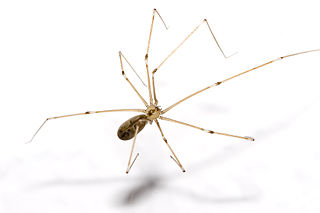
The Pholcidae are a family of araneomorph spiders. The family contains over 1,800 pholcids, including those commonly known as the marbled cellar spider , daddy long-legs spider, granddaddy long-legs spider, carpenter spider, daddy long-legger, vibrating spider, gyrating spider, long daddy, and skull spider. The family, first described by Carl Ludwig Koch in 1850, is divided into 94 genera.

Velvet spiders are a small group of spiders almost entirely limited to the Old World, with exception of a few species known from Brazil. The characteristics of this family of spiders are that they are entelegyne, eight-eyed araneomorph spiders that build unkempt webs. They are cribellate. Some species are nearly eusocial, lacking only a specialized caste system and a queen. They cooperate in brood rearing, unlike most other spiders except for some African agelenid spiders in the genus Agelena and a few others.

Spider taxonomy is that part of taxonomy that is concerned with the science of naming, defining and classifying all spiders, members of the Araneae order of the arthropod class Arachnida with about 46,000 described species. However, there are likely many species that have escaped the human eye to this day, and many specimens stored in collections waiting to be described and classified. It is estimated that only one third to one half of the total number of existing species have been described.

Chliaria is a butterfly genus in the family Lycaenidae. The species of this genus are found in the Indomalayan realm.

Tarantulas comprise a group of large and often ″hairy″ spiders of the family Theraphosidae. Currently, about 1,000 species have been identified. The term tarantula is usually used to describe members of the family Theraphosidae, although many other members of the same infraorder (Mygalomorphae) are commonly referred to as "tarantulas" or "false tarantulas". Some of the more common species have become popular in the exotic pet trade. Many New World species kept as pets have urticating hairs that can cause irritation to the skin, and in extreme cases, cause damage to the eyes.
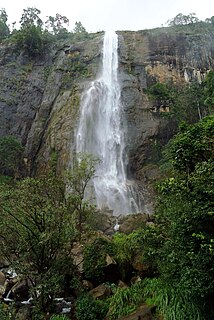
Diyaluma Falls is 220 m (720 ft) high and the second highest waterfall in Sri Lanka and 361st highest waterfall in the world. It is situated 6 km (3.7 mi) away from Koslanda in Badulla District on Colombo-Badulla highway. The Falls are formed by Punagala Oya, a tributary of Kuda Oya which in turn, is a tributary of Kirindi Oya.

Spiders are air-breathing arthropods that have eight legs, chelicerae with fangs generally able to inject venom, and spinnerets that extrude silk. They are the largest order of arachnids and rank seventh in total species diversity among all orders of organisms. Spiders are found worldwide on every continent except for Antarctica, and have become established in nearly every habitat with the exceptions of air and sea colonization. As of July 2019, at least 48,200 spider species, and 120 families have been recorded by taxonomists. However, there has been dissension within the scientific community as to how all these families should be classified, as evidenced by the over 20 different classifications that have been proposed since 1900.
The World Spider Catalog (WSC) is an online searchable database concerned with spider taxonomy. It aims to list all accepted families, genera and species, as well as provide access to the related taxonomic literature. The WSC began as a series of individual web pages in 2000, created by Norman I. Platnick of the American Museum of Natural History. After Platnick's retirement in 2014, the Natural History Museum of Bern (Switzerland) took over the catalog, converting it to a relational database.
Pahanga is a genus of Asian araneomorph spiders in the family Tetrablemmidae that was first described by W. A. Shear in 1979.















